Strudel is a layered, usually sweet pastry, with origins dating back to 17th century in the Habsburg Empire. Today it is still very popular in Austria, throughout Eastern and Central Europe, as well as the Western Balkans. Traditionally it is made with unleavened dough. The basic dough contains high protein flour, water, salt and sometimes oil. The dough has to be kneaded vigorously and then rested. This will allow stretching the dough to a very thin paper like layer. If done properly you should without difficulty, be able to read through the stretched dough.
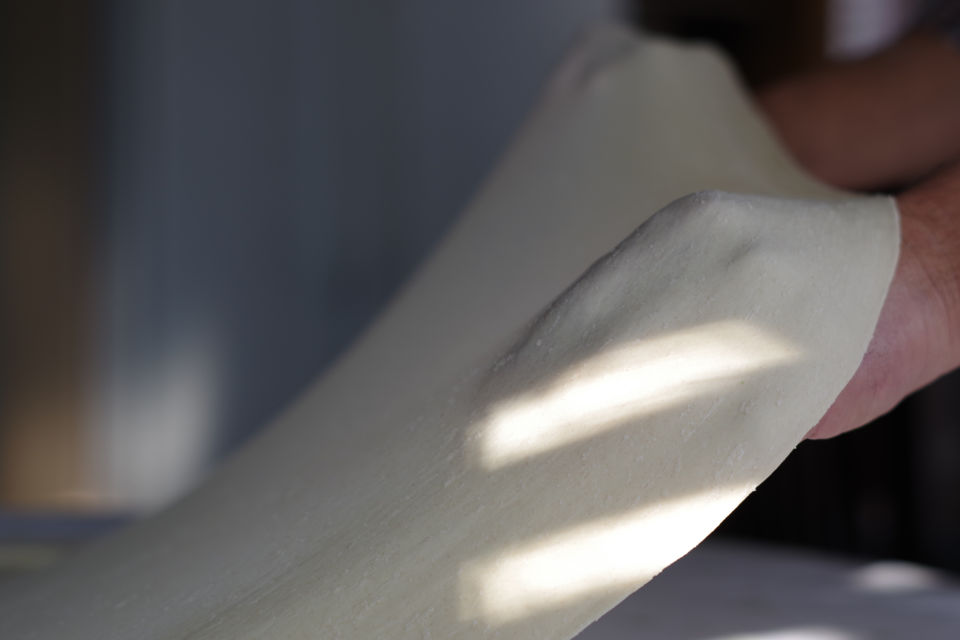
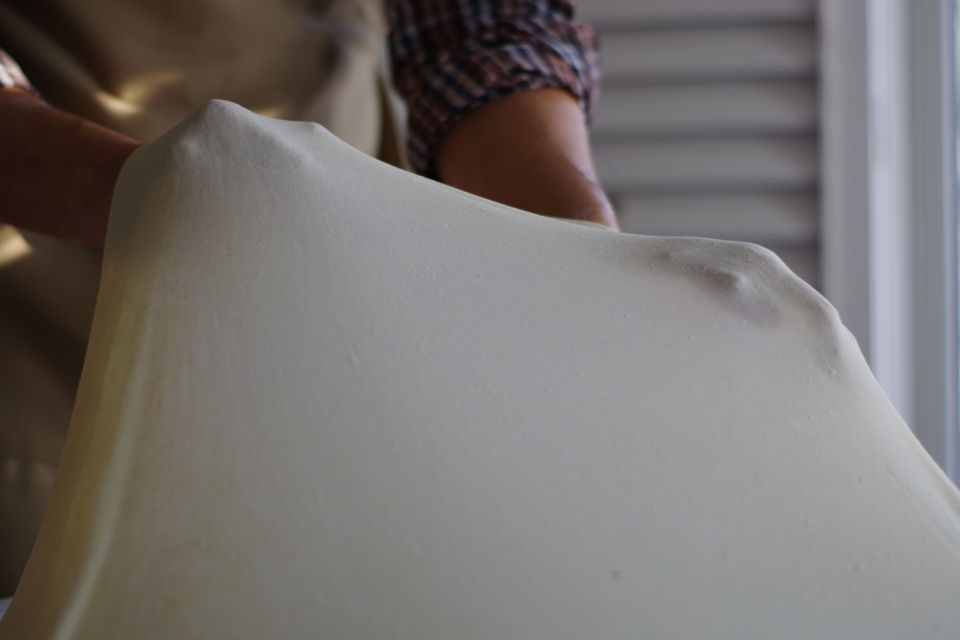
I already have a blog post for apple strudel that was made with similar but slightly different dough. That dough contained oil in the recipe and this one does not. Fresh sour cherries are precious and sometime hard to find. In Southwestern Ontario, harvesting season is in early August and that is when I collect all I need for my baking. I like them best when they are fresh, but for obvious reasons I also keep them frozen for use during the rest of the year. Sour cherries strudel is characterized by its refreshing taste, sweet and sour flavour, but also by its wonderful crunchy texture. The crunchy texture comes from the rolled thin dough layers.

Properly developing or stretching a thin dough layer is a key component for the success of this sweet pastry. I enjoy that part a lot and find it almost meditative-like experience. The dough is so pliable and elastic; it is true pleasure to work with it. From my experience, I would say the secret is in your confidence. There is nothing special about the stretching technique, there are no special or secret moves. Trust yourself and you will succeed.
Few key pointers to pay attention to are as follows:
- knead the dough for about 10 minutes, and let it rest for 30 minutes
- remove any sharp objects from your hands, such as jewelry
- clip your nails
- keep stretching the dough outwards starting from the middle
- stretch the dough either with the top of your bent wrists and knuckles or with the tips of your fingers
Do not rush, just carefully follow this simple recipe procedure and I am convinced you will end up with a delicious sour cherry strudel that you can share with your loved ones.
The recipe uses a very small amount of fat and sugar which puts it in a light category as far as its caloric energy value.
As an added bonus once you are comfortable with dough stretching, you can explore with other sweet and salty fillings, options are limitless.


| Prep Time | 45 minutes |
| Cook Time | 30 minutes |
| Passive Time | 30 minutes |
| Servings |
servings
|
- 280-300 g all purpose non bleached flour sifted
- 200 ml water warm
- 3/4 tsp sea salt
- 500 g sour cherries pitted, fresh or defrosted and drained
- 100 g granulated sugar sprinkled
- 2-3 tbsp cream of wheat sprinkled
- vegetable oil for brushing
Ingredients
Dough
Filling
|

|
- In a medium size mixing bowl add warm water and half of the flour, mix together. Mix in the salt.
- Add the rest of the flour and mix by hand until you create a compact mass. Take it out on the counter and knead it vigorously for about 10 minutes. If the dough is sticky, sprinkle on some flour as needed. Do it in small increments, a little at a time. The goal is to obtain a soft, non sticky dough. Throw the dough often at the counter and then roll it up using the palm of your hand. Keep repeating that process until the end. This will greatly help in developing proper gluten structure.
- Form the dough ball and let it rest for 30 minutes, at room temperature, placed between two clean and floured kitchen towels.
- Put a clean tablecloth (material does not matter) on a large table. Flour the center area of the table cloth, area with diameter of approximately 50 cm (20 ").
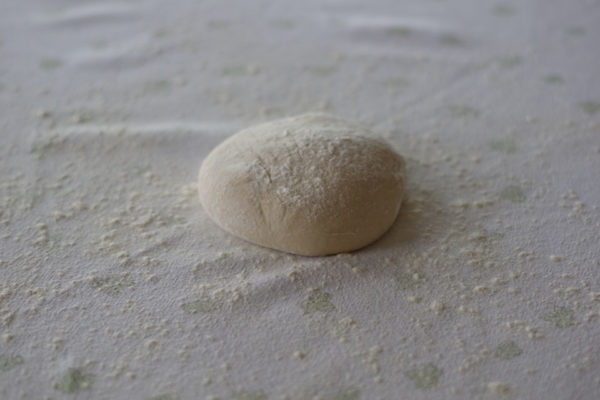
- Place the dough ball in the center of the floured table cloth. Using a rolling pin, gently stretch the dough evenly to about size of the floured area or 50 cm (20") diameter. Let rest for 5 minutes.
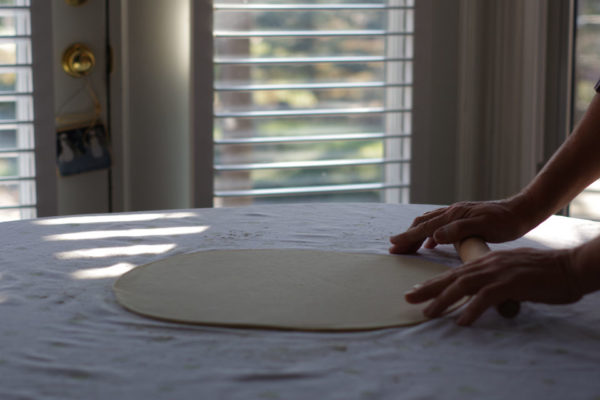
- Stretch the dough to the full size of the table and let it drape over the table edges (see instructions below).
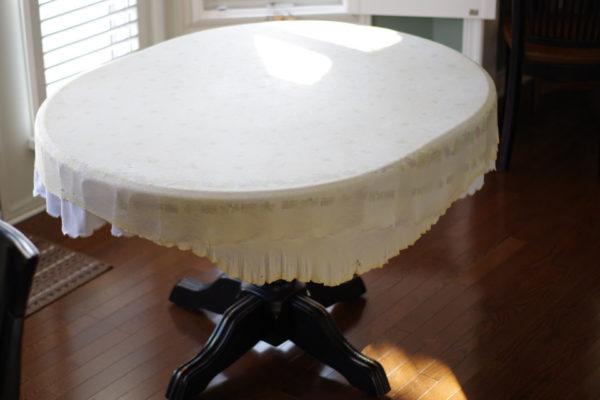
- Fold in dough ends, creating a rectangular dough shape.
- Brush the top of the dough with vegetable oil.
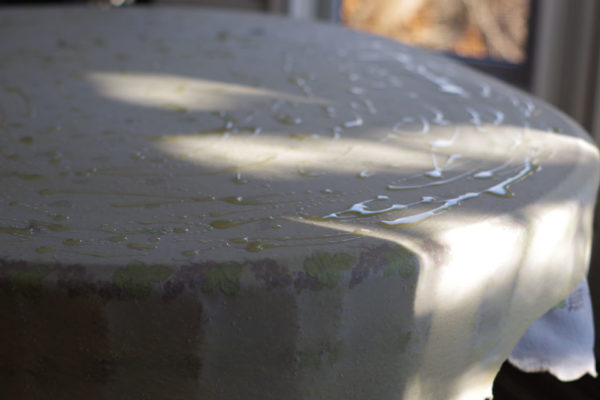
- Distribute sour cherries evenly over half of the dough surface, the half that is closer to you.
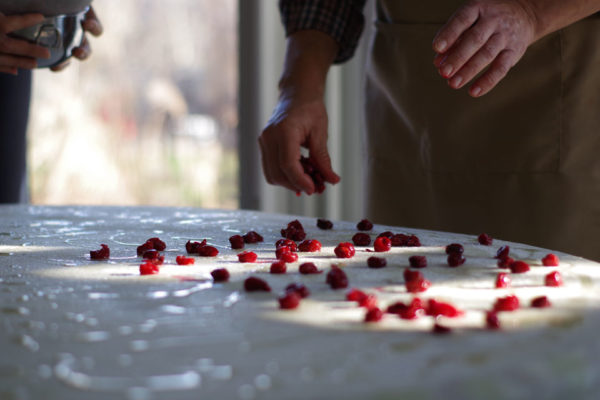
- Sprinkle the cherries with sugar and cream of wheat.
- Roll the strudel using the table cloth, starting from your side. When rolled completely with sharp knife cut the strudel in even lengths that will fit your baking pan.
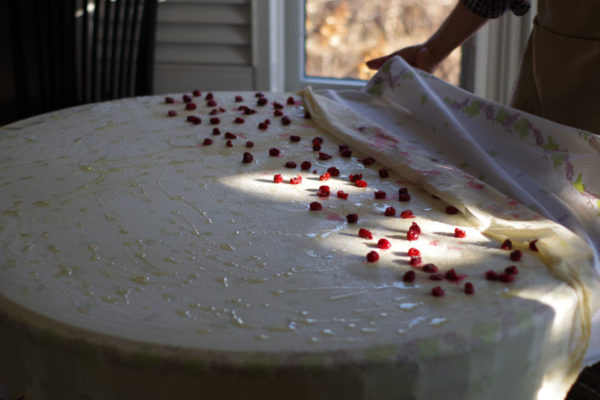
- Place the strudel on a parchment paper-lined baking pan and brush the top with vegetable oil.
- Bake for 30-35 minutes (conventional oven) at 176 ºC (350 ºF) until golden brown, with the rack placed in the middle of the oven.
- Let it cool off for at least 30 minutes. Using serrated knife cut into thick slices and serve warm. Sprinkle with confectioners' sugar.
Stretching dough procedure:
Pick the dough up from the table cloth, being careful not to tear it. Put both of your hands in the middle, and let the dough rest on top of your bent down wrists, draping down over your knuckles. Gently spread your hands apart by 10-15 cm (4"-5"), stretching the dough. Rotate the dough and repeat. When the dough becomes big and cumbersome to work with place it carefully flat on the table cloth. Again insert your both hands under the dough in the same manner as before, having the dough resting on top of your bent down wrists. Only this time hands are not in the middle but 10-15 cm (4'-5") in from the edge. Stretch the dough by pulling gently both hands towards you. As you pulling towards you at the same time keep spreading hands apart from each other. This way you will be stretching the dough in two directions at the same time. Repeat the same process around the dough perimeter until only 10-15 cm from the dough edge remains unstretched. At that point, use the tips of your fingers, palms up, to gently pull on the edge in small increments as you work around perimeter until completely stretched. Don't lift it up; it is easier to work if you maintain a low angle where stretching the dough is kept almost level to the table top.
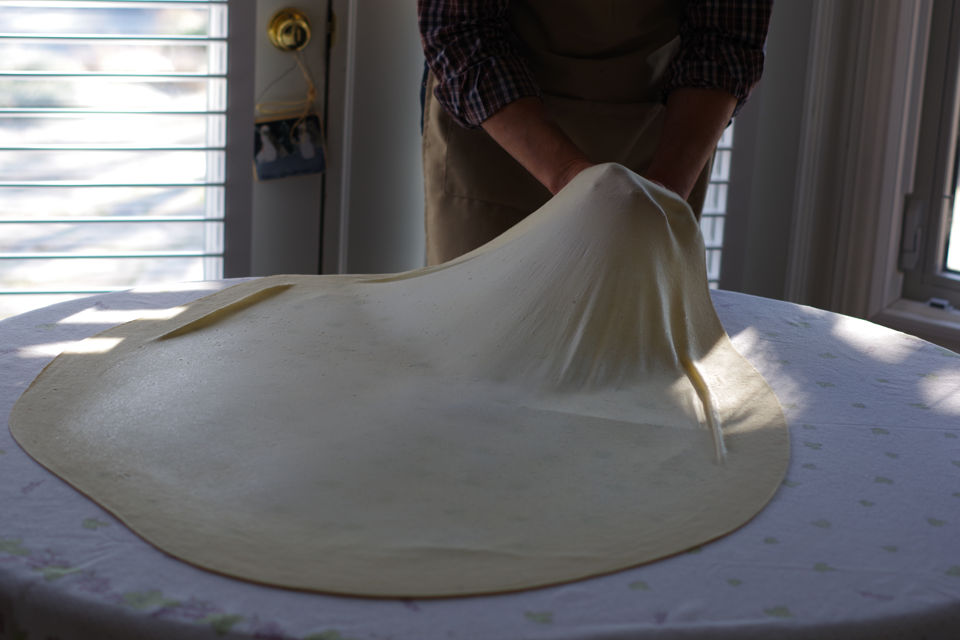
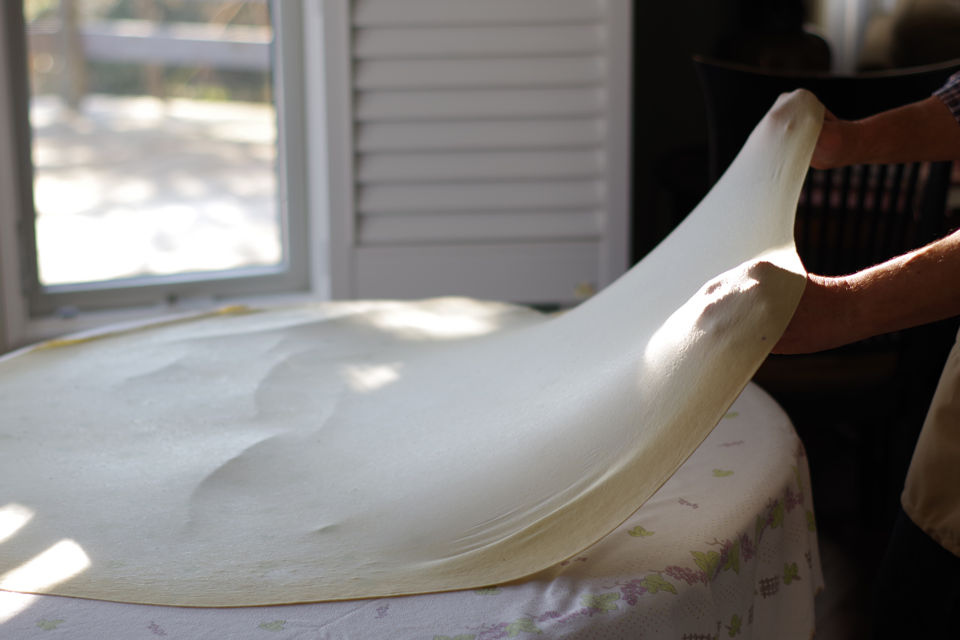
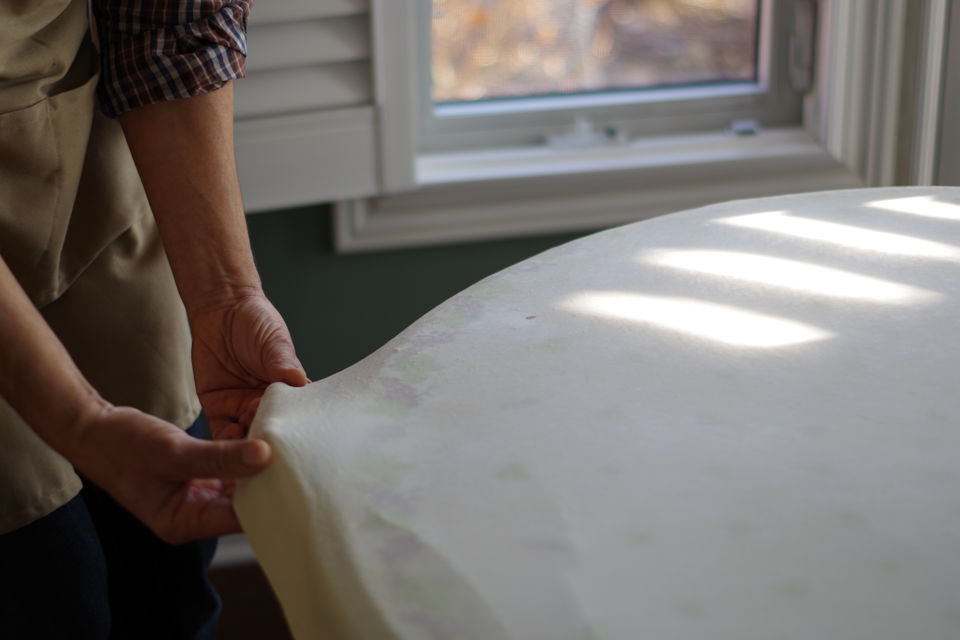


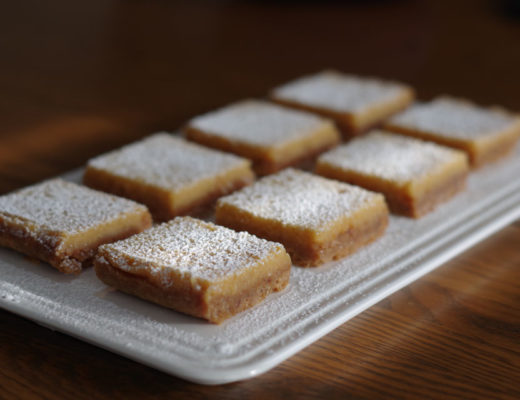


No Comments